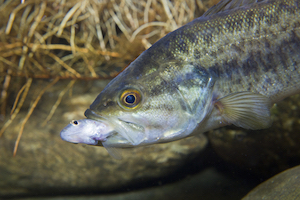Largemouth Bass Lake Fishing

Lake fishing tips – what you need to know
Largemouth bass prefer lakes that contain weeds, brush, rock areas, drop off areas and sunken trees.
Lakes and rivers start cooling off in the north in late August while the southern lakes don’t start cooling off until October.
Don’t look for these fish near the mouths of fast-moving streams as they don’t like fast moving water.
Largemouth bass like to wait in ambush for their prey.
Bass are highly sensitive to sound vibrations. If you can replicate the sounds of injured fish you’ll increase your chances of catching more bass. Make sounds uncommon to their habitat and you will scare them away.
Best lures for largemouth are those that create vibrations and annoy the bass. Buzzbaits, spinnerbaits and spoons are all very effective.
- The largemouth bass have external lips that are sensitive to taste so you had better set the hook on the first strike
- Sensitive nostrils can smell traces, in parts per million
- Water temperature makes a difference too and spring water temperatures are generally cooler so the bass tend to look for still waters that warm faster
Sonic Lures
Sonic lures work well once you’ve fine tuned them to create the right distress vibration resembling those of the common forage.
An alternative to the sonic lure is to trigger a feeding reaction by clipping a portion of the tail of a bait fish, prompting it to elicit distress signals.
Spring Lake Fishing
Before spring Largemouth Bass spawn, water temperatures are ideal for some of the best fishing of the year.
Bass spawning occurs throughout the spring. Be mindful of the areas closed to fishing. This is especially pertinent to smaller lakes, particularly lakes in northern United States and southern Canada where the warm growing season is short and the limited breeding population is vulnerable to over-fishing.
Fish caught during the spring should be carefully reeled in.
Hold them by the lower lip and partially out of the water while the hooks are gently removed, and then released. Be sure to cradle them until they swim away rather than just letting them go. This increases their chances of survival.
Bass fishing in the spring is directly influenced by the weather. Bass are slow and not fast to move until the temperature warms up above 56°F/13°C.
Cold Winter and Fall
Lakes and rivers start cooling off in the north in late August while the southern lakes in the largemouth bass’ distribution doesn’t start cooling off until October when cold fronts come through.
Once the temperature drops into the mid to high 50°F’s the Largemouth Bass become very inactive, moving to deeper water.
The best way to catch the bass in these months is using lures that appeal to their sense of territory or irritate them. Buzzbaits, spinner baits and spoons are all very effective lures at creating vibrations and annoying the bass.
Just make sure that you cast your bait within a few feet of the bass.
Competitions and Tournaments
Most largemouth bass competitions are held in lake or reservoir environments. Each year ESPN broadcasts the Wal-Mart Forrest L Wood Tour, which pays out $1,000,000 in prizes, which should help put in perspective where ESPN thinks the best habitat is for fishing. Oh, the lake where they hold the tournament is Lake Mead.



